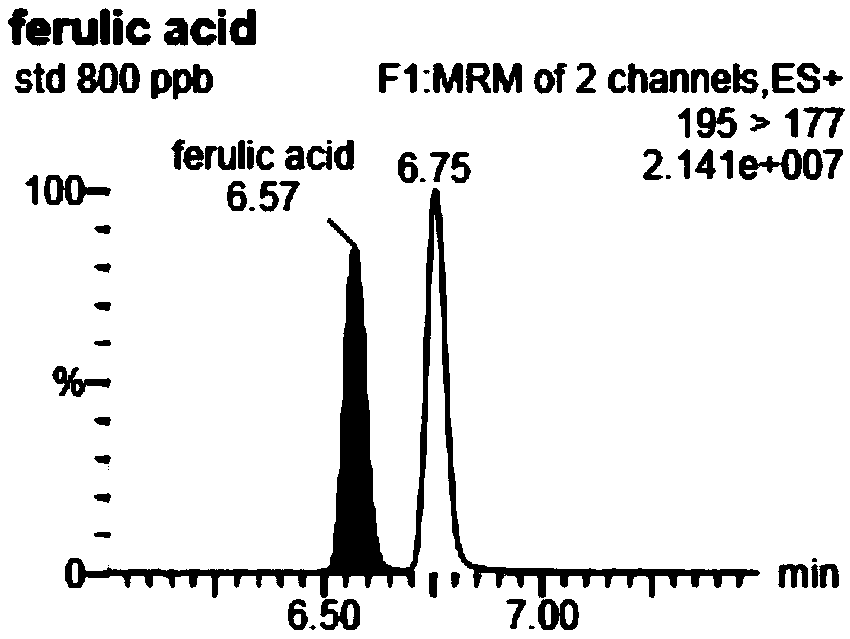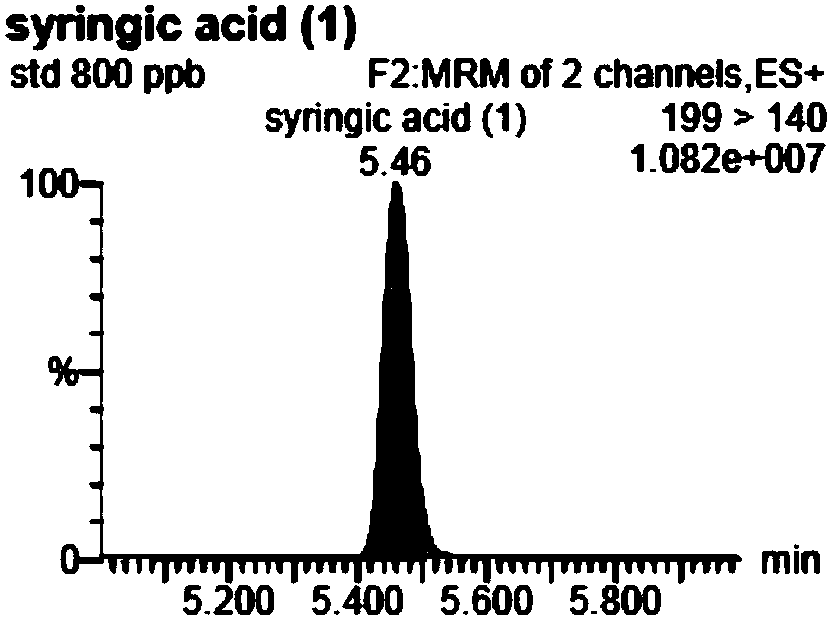Marker combination used for determining antioxidant activity of honey sample as well as method
A technology of antioxidant activity and markers, which is applied in the direction of measuring devices, instruments, scientific instruments, etc., can solve the problems of accuracy, sensitivity and selectivity reduction, and restrict antioxidant activity, etc., and achieve good reproducibility and fast sample processing Simple and effective with less dosage
- Summary
- Abstract
- Description
- Claims
- Application Information
AI Technical Summary
Problems solved by technology
Method used
Image
Examples
Embodiment 1
[0069] Example 1: Analysis of Phenolic Acids and Flavonoids in Each Honey Sample
[0070] Take the aforementioned honey samples and perform MAX solid-phase extraction-ultra-high performance liquid chromatography-triple quadrupole mass spectrometry to analyze various phenolic acids and flavonoids, and obtain the spectrum of flavonoids and phenolic acids in each honey sample peak data.
[0071] The MAX solid phase extraction method uses 10g of honey to be dissolved in 50ml of 0.5% ammonia water, centrifuged at 10000rpm for 5min, and the whole supernatant is passed through a 1g MAX solid phase extraction column pre-balanced with 0.5% ammonia water, and 30mL of 2% formic acid is collected after being eluted with 50mL of ultrapure water The methanol eluate was concentrated to dryness by nitrogen blowing, then dissolved in 1 mL of methanol and filtered at 0.22 μm for analysis.
[0072] UHPLC with ACQUITY HSS T3column (2.1×100mm, 1.8μm) chromatographic column, with 0.1% formic a...
Embodiment 2
[0078] Example 2: Analysis of Amino Acids in Individual Honey Samples
[0079] The aforementioned honey samples were taken and subjected to pre-column derivatization-high performance liquid chromatography-fluorescence analyzer to analyze amino acid compounds. Use AccQ·Tag Ultra derivatization reagent (6-aminoquinoline-N-hydroxysuccinimidyl carbamate) to derivatize amino acids. Both primary and secondary amino acids can be rapidly and quantitatively derivatized to produce highly stable, Fluorescent adducts.
[0080] Dissolve every 3g of honey in 15ml of ultrapure water, centrifuge at 10,000rpm for 5min, take 10μl of the sample solution, add 20μl of derivatization reagent and 170μl of boric acid buffer to the sample derivation tube, vortex for 1min, then transfer to the inner tube of the autosampler bottle, After adding at 55°C for 10 minutes, it was analyzed on the machine, using Waters amino acid analysis special column 3.9×150mm, column temperature 37°C, excitation wavelen...
Embodiment 3
[0086] Embodiment 3: Determination of total phenols and total flavonoids in each honey sample
[0087] Because it cannot be guaranteed that the monomeric compounds in Example 1 cover all phenolic acids or flavonoids monomeric compounds in honey, the expression of total phenols and total flavonoids as components is added here, when constructing the group-effect relationship spectrum in chemometrics It is also used as two columns of X variables, which are parallel to the monomer quantitative peak data in 4, and are both used as X variables.
[0088] (1) Determination of total phenols in honey
[0089] Take the aforementioned honey sample, ultrasonically dissolve it with ultrapure water and dilute it to a concentration of 0.16g / mL, use the Folin-Ciocalteu method to determine the total phenol content, and prepare 0.2N Folin-Ciocalteu reagent and 75g / L sodium carbonate solution. Add 30 μL of honey solution, 150 μL of Folin-Theocat reagent, and 120 μL of sodium carbonate solution...
PUM
 Login to View More
Login to View More Abstract
Description
Claims
Application Information
 Login to View More
Login to View More - R&D
- Intellectual Property
- Life Sciences
- Materials
- Tech Scout
- Unparalleled Data Quality
- Higher Quality Content
- 60% Fewer Hallucinations
Browse by: Latest US Patents, China's latest patents, Technical Efficacy Thesaurus, Application Domain, Technology Topic, Popular Technical Reports.
© 2025 PatSnap. All rights reserved.Legal|Privacy policy|Modern Slavery Act Transparency Statement|Sitemap|About US| Contact US: help@patsnap.com



